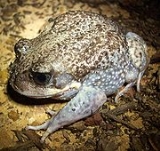
Giant Burrowing Frog
Encyclopedia
The Giant Burrowing Frog (Heleioporus australiacus) is a large frog species that occurs in coastal south east New South Wales
and Victoria
in Australia
 This species inhabits sandstone heathland, dry, and also wet sclerophyll forest from north of Sydney to eastern Victoria. They are called burrowing frogs because of their burrowing ability. They are also known as the Eastern Owl Frog because of their mating call, which resembles the hooting of an owl
This species inhabits sandstone heathland, dry, and also wet sclerophyll forest from north of Sydney to eastern Victoria. They are called burrowing frogs because of their burrowing ability. They are also known as the Eastern Owl Frog because of their mating call, which resembles the hooting of an owl
. Males call from burrows on the edges of streams during autumn and spring after heavy rainfall. Eggs are laid in burrows on the shores of creeks and streams, to be washed into the water during heavy rainfall. The tadpoles develop in the creek and take 3–11 months. The tadpoles are very large in size, up to 80mm.
This is quite a large species of frog and the largest frog in Victoria. It is often mistaken for Cane Toad
s because of its large size of 9 to 10 cm and bumpy skin. However cane toads do not have vertical iris and the range of the cane toad currently does not overlap into Giant Burrowing Frog habitat.
These frogs can be seen sitting out on the edges of roads and walking tracks at night, after rain in areas of favourable habitat. This species has decline due to urbanisation and is mostly restricted to National Parks and State Forests.
New South Wales
New South Wales is a state of :Australia, located in the east of the country. It is bordered by Queensland, Victoria and South Australia to the north, south and west respectively. To the east, the state is bordered by the Tasman Sea, which forms part of the Pacific Ocean. New South Wales...
and Victoria
Victoria (Australia)
Victoria is the second most populous state in Australia. Geographically the smallest mainland state, Victoria is bordered by New South Wales, South Australia, and Tasmania on Boundary Islet to the north, west and south respectively....
in Australia
Australia
Australia , officially the Commonwealth of Australia, is a country in the Southern Hemisphere comprising the mainland of the Australian continent, the island of Tasmania, and numerous smaller islands in the Indian and Pacific Oceans. It is the world's sixth-largest country by total area...
Physical description
This is a large species of frog, up to 10 cm in length. It is normally grey, dark brown or black on the back. It is white on the belly. There are yellow spots on the side and a yellow stripe on the upper lip, from the back of the eye to the back of the typanum. In metamorph frogs, this stripe is pink-orange in colour. The skin is rough and bumpy, males often have black spines on their fingers during the breeding season. This iris is silver and the pupil is vertical.Ecology and behaviour

Owl
Owls are a group of birds that belong to the order Strigiformes, constituting 200 bird of prey species. Most are solitary and nocturnal, with some exceptions . Owls hunt mostly small mammals, insects, and other birds, although a few species specialize in hunting fish...
. Males call from burrows on the edges of streams during autumn and spring after heavy rainfall. Eggs are laid in burrows on the shores of creeks and streams, to be washed into the water during heavy rainfall. The tadpoles develop in the creek and take 3–11 months. The tadpoles are very large in size, up to 80mm.
This is quite a large species of frog and the largest frog in Victoria. It is often mistaken for Cane Toad
Cane Toad
The Cane Toad , also known as the Giant Neotropical Toad or Marine Toad, is a large, terrestrial true toad which is native to Central and South America, but has been introduced to various islands throughout Oceania and the Caribbean...
s because of its large size of 9 to 10 cm and bumpy skin. However cane toads do not have vertical iris and the range of the cane toad currently does not overlap into Giant Burrowing Frog habitat.
These frogs can be seen sitting out on the edges of roads and walking tracks at night, after rain in areas of favourable habitat. This species has decline due to urbanisation and is mostly restricted to National Parks and State Forests.

